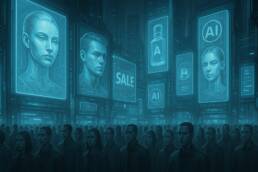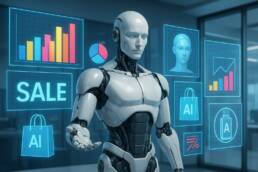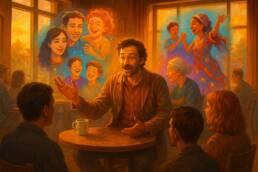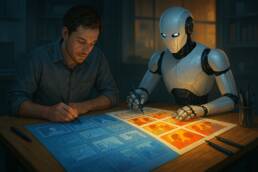It’s efficient, fast, and cheap. Every brand, big or small, would have access to the same production quality as top advertising agencies. The gap between companies would vanish.
But here comes the paradox: if everything becomes perfect, what still manages to truly impress us?
A world flooded with AI-generated campaigns would be uniform. All optimized, but all soulless. We’d be surrounded by flawless visual content… yet cold.

How AI tells stories: algorithmic, rational, focused on data and efficiency
AI works like a super-calculator of storytelling. It knows exactly:
- which colors increase conversion rates by 12%,
- which type of music triggers more empathy,
- which video sequence captures attention in the first 3 seconds.
The story created by AI is technically impeccable: clear, concise, optimized. But it lacks that “something” that makes the difference between a good ad and a memorable one.It’s like a speech written by a linguist: correct, flawless… but passionless.
AI stories are like mathematical puzzles: every piece fits perfectly, but none surprises.
Concrete example:
An AI would present a perfume with a clip showing: slow motion, warm colors, a model with a perfect smile, and a slogan optimized for impact.
But a human storyteller might add a personal memory: perfume as a symbol of first love, a summer evening, the imperfection of a real moment. And that very imperfection would become unforgettable.

How humans tell stories: emotions, imperfections, cultural context, micro-narratives
Humans tell stories differently.
Our stories have:
- long pauses,
- hesitations,
- seemingly useless details,
- cultural accents.
And precisely those imperfections make a story authentic.
When a parent talks about their child, their voice cracks.
When a grandfather recalls his youth, there’s a shy smile. When someone tells a joke, the laughter isn’t perfectly timed. But that’s what makes the audience feel it’s real.
A human-made video isn’t only about “what looks good,” but also about context: traditions, emotions, cultural ties. A storyteller can reveal a brand’s essence through a small gesture, an “accidental” shot, or a glance that wasn’t in the script.
Concrete example:
An AI-generated coffee ad would show the perfect cup, the correctly animated steam, the ideal lighting. A human-made coffee ad would show a grandmother spilling a little coffee on the table, laughing, and then telling her grandchild a story. Perfection fades, but emotion emerges.

What happens when the two combine: the ideal hybrid of AI and creative teams
The future of storytelling isn’t “AI vs. humans.” It’s “AI + humans.”
AI can:
- analyze data,
- generate dozens of script variations,
- suggest efficient narrative structures.
But humans decide the right tone, introduce emotional imperfections, and make the story resonate culturally.
A brand that uses only AI will produce optimized but generic content.
A brand that uses only humans will produce authentic stories, but harder to scale.
A brand that combines both worlds will achieve content that is relevant, emotional, and efficient.

Conclusion: Brands of the future will have to choose
As AI grows stronger, brands will face a decision:
– Will they settle for “correct” content, technically flawless but lifeless?
– Or will they dare to blend AI precision with human sensitivity to craft memorable stories?
At Cabo Studio, we believe the future of video won’t be just about how fast you can create, but about how deeply you can connect.
Because in the end, people don’t remember what they saw. They remember what they felt.
